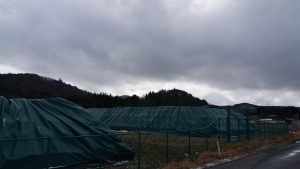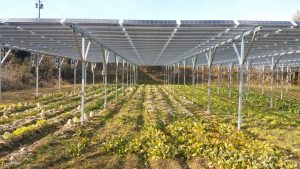From our reading materials, we’ve learnt a lot about the disastorous tsunami that happened 8 years ago in Fukushima. According to the data online, more than 15 000 people were killed, over 6000 were injured, and at the time of this report around 2500 people are still reported to be missing. Radionuclides such as iodine-131, caesium-134 and caesium-137 were released and found in drinking water, food and some non-edible items. It warns Japanese people and government to stop their extreme dependence on technology on building their communities.
We went on a field trip to Fukushima today and take a close look of the reconstruction after disaster. Radioncuclides have already destroyed almost everything in that town unfortunately. Many people from Nihonbusa lost their homes forever, while some of them managed to come back again in recent years. On our way, what we could see was merely plastic bags containing highly-density radioactive soil, meters measuring the radioactive level, and several newly built houses on that almost deserted land. After the disaster the ashes could be super radioactive so the top soil was put into a huge plastic bag to keep from radiation, and later they might go for incineration, or go to the nuclear landfill site. Also, local government took around 300 million dollars to build a local school by specific materials which could protect kids from remaining radioncuclides there.

The plastic bag that contains the unproceeded highly radioactive soil
Food safety is one of the most significant issue after Fukushima. Farmers in Litate and Nihonbusa lost their land to farm and forced to leave. The other farmers, who remained in Fukushima, the food safety has been challenged. In Cinterna’s article about food safety after Fukushima he mentioned that the consumers are worried about the food safety, many of them refused to buy any food products from affected area even though most of them has proved to be safe. A lot of consumers did not trust the government and demanded the government to let them directly reach out the radioactive testing processes. One organic farmer today told us about his struggle during disaster that he lost most of his consumers, clerks and resources on teikei system and he faced economical trap to keep on his farm. However, as long as some people started supporting the Fukushima farmers their conditions got much better, and that motivated them to keep farming in Fukushima.
Mums are extremely worried about the food safety of their kids after disaster. There are stories of Mums open vegetable shop due to her concerns about the food safety in Fukushima. At the same time the trust of mothers could give local farmers the most support. It is usually the strongest motivation for local farmers to keep going on, as the lecturer today is high motivated when a pregant woman became the very first consumers of their products after disaster.
After nuclear disaster, the government in Litate and Nihonbusa were forced to give up nuclear power and built solar panels, wind energy, and waterflow energy to generate electricity. For example in Kobayashi village there are now 5964 solar panels installed for energy. Local people share the energy generated by the solar panels and the plants grow beneth them. What is insteresting is people grow vegetable under the solar panels. It might because that the panels absorb much sunlight and provide good shade for the vegetable to grow, while there is still considerable, but not too much amount to light reaching vegetable. I think the solar panels are excllent materials for reconstruction, as long as they not only solve the electricity generation for the new residents, also, as long as new residents could grow very good vegetable under the panels, it makes them ecomical independent after disaster.

The solar panels, vegetable grows 10 feet beneth them
Curretly it is just the beginning of the recovery of Litate and Nihonbusa, which are the most damaged towns in Fukushima disaster. I think tull recovery will probably take more than 20 years in terms of the damaged I know about. However, Fukushima nuclear accident not only brings people economical damages, it also damages people even more severe mentally. Some people suffer from irreversible psychoneurosis diseases caused by disaster. Many people have horrible memories about the disaster that pass them out at time. People are forced to move out of their home with great despair that they will never see the beauty of their home again. Litate, however it will be recovered, it will never return back to how it used to be even decades after. All of the disasters called by Fukushima nuclear power plans make it a great lesson in a global level.
Recent Comments